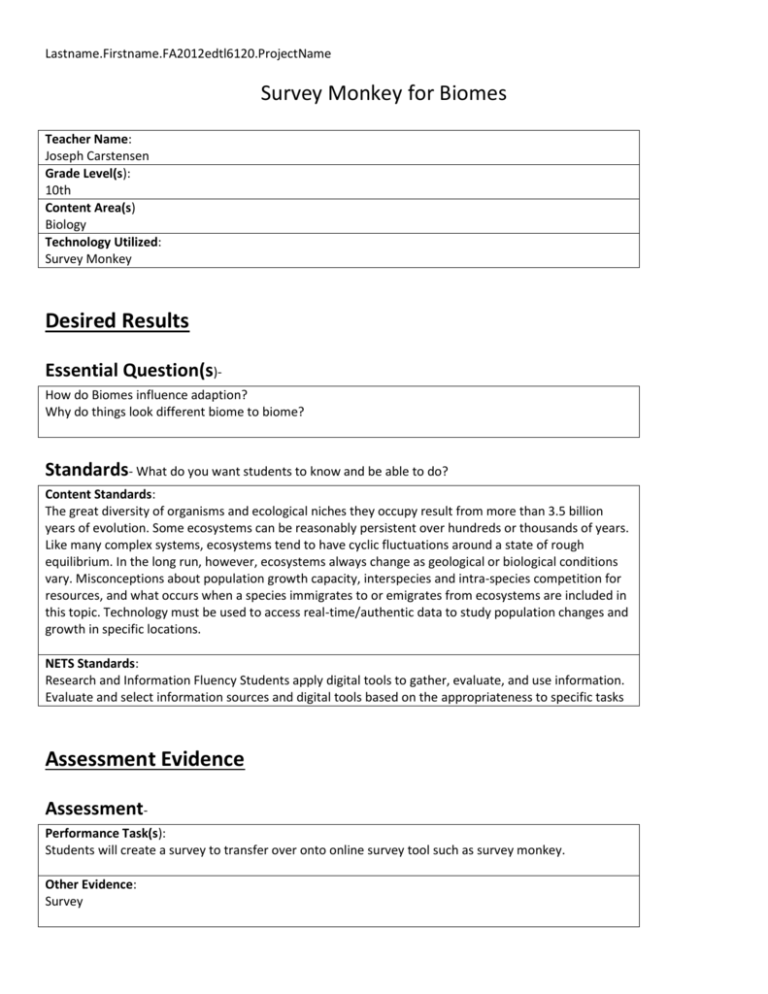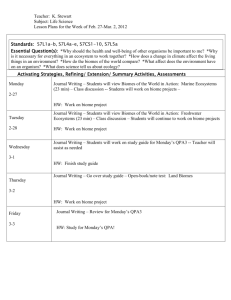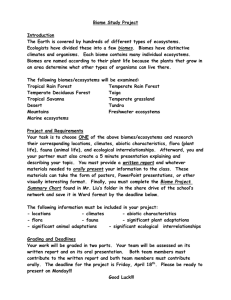
Lastname.Firstname.FA2012edtl6120.ProjectName
Survey Monkey for Biomes
Teacher Name:
Joseph Carstensen
Grade Level(s):
10th
Content Area(s)
Biology
Technology Utilized:
Survey Monkey
Desired Results
Essential Question(s)How do Biomes influence adaption?
Why do things look different biome to biome?
Standards- What do you want students to know and be able to do?
Content Standards:
The great diversity of organisms and ecological niches they occupy result from more than 3.5 billion
years of evolution. Some ecosystems can be reasonably persistent over hundreds or thousands of years.
Like many complex systems, ecosystems tend to have cyclic fluctuations around a state of rough
equilibrium. In the long run, however, ecosystems always change as geological or biological conditions
vary. Misconceptions about population growth capacity, interspecies and intra-species competition for
resources, and what occurs when a species immigrates to or emigrates from ecosystems are included in
this topic. Technology must be used to access real-time/authentic data to study population changes and
growth in specific locations.
NETS Standards:
Research and Information Fluency Students apply digital tools to gather, evaluate, and use information.
Evaluate and select information sources and digital tools based on the appropriateness to specific tasks
Assessment Evidence
AssessmentPerformance Task(s):
Students will create a survey to transfer over onto online survey tool such as survey monkey.
Other Evidence:
Survey
Lastname.Firstname.FA2012edtl6120.ProjectName
Learning Plan
Overview- This is a short summary of the lesson or unit including assignments or possible products.
Students will create a survey about biomes to find out what people know about them. Then students
will analyze the data to see if there are any misconceptions. Then students will develop a plan to
address the misconceptions.
Resources- What resources will you use in your project (e.g., digital tools, web pages, print resources, etc.)?
Computers with access to the internet.
Printer with paper
www.surveymonkey.com
Preparation- What student needs, interests, and prior learning provide a foundation for this lesson?
This would be an extend activity in which students analyze others understanding of the material
compared to their own. It would hopefully help keep them engage them in the material.
Management- How and where will your students work (classroom, lab, groups, etc.)?
The students will begin their work in class to first come up with survey question then move to a
computer lab. Then break into groups of 4 to discuss and analyze the survey results produced.
Outline and Timeline for Instruction and Activities - List the learning activities you will use and
provide a timeline that indicates what students must complete and by when.
Day 1 Bio Block
1. 5 mins to explain what activity.
2. 10 mins assign groups and topics
3. 65 mins to research topics and develop survey questions.
Day 2 Bio block
1. 40 mins to transfer survey questions to online site.
2. 40 mins students complete each other’s surveys, as well as other classes’ surveys.
Day 3 Bio Block
1. 80 mins to analyze results and develop plan to address misconceptions.
Instructional strategies- Describe how you will use any of the strategies listed below in your unit/lesson.
(Only include what you are utilizing)
Project-Based Learning: creating survey
Inquiry-Based Learning:
Lastname.Firstname.FA2012edtl6120.ProjectName
Constructivism: they are becoming masters in one biome to share with the rest.
Learning Centers:
Collaborative Groups: looking at others results and addressing results
Differentiated Instruction:
Other:
Closure and Reflection- How will you wrap up the unit/lesson?
How will students reflect upon their work?
Students present how they will address misconceptions.
Adapted from: National Educational Technology Standards for Students, Second Edition, © 2007, ISTE ® (International Society for Technology in Education), www.iste.org. All rights reserved.








